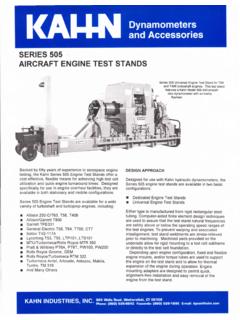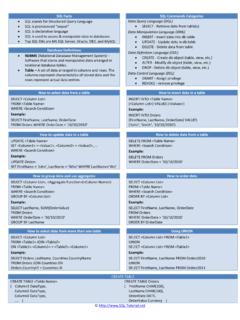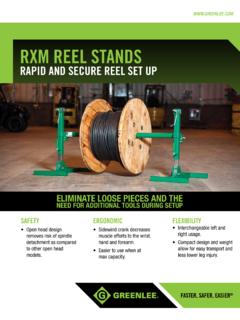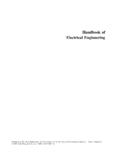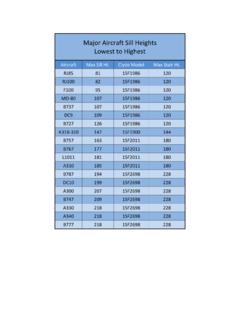Transcription of Thinning Pine Plantations - Georgia Forestry
1 Thinning is a forest management practice thatis generally performed at some point(s) in timeduring the course of the growth and development ofboth natural and planted pine stands. Thinning (as a forestmanagement practice) can be defined as the calculatedremoval of certain trees from an existing stand and is usuallyconducted with a specific objective in are various reasons why Thinning should be employedas a management practice in pine stands. Thinningpromotes the growth of individual trees within a stand byremoving surrounding trees, which compete for water,sunlight, and soil nutrients. Most natural and planted standsrequire Thinning at certain stages of their development inorder to sustain good tree growth throughout the life of thestand.
2 Thinning is beneficial to the overall health of a standof trees. Certain methods of Thinning allow for the removalof a greater portion of diseased trees and trees that are ofpoor quality and form. Many of these poorly formed,cankered trees will die before the final harvest. Thereforethe landowner is capturing an early economic return withthe Thinning (removal) of these poor quality trees. Thinningcan be effective in enhancing habitat for certain INDICATORSA common question from landowners is: When should Ithin my stand of trees? The answer to this largely dependson their objective(s) for the stand. Most landowner objectivesinvolve three major factors: rotation age, products to begrown (pulpwood, sawtimber, poles, pine straw), and standhealth/vigor assuming timber production is a high are several indicators (of stand conditions) that canaid in determining when a stand should be thinned: Live Crown Ratio (of trees in a stand) is defined asthe height of the live crown (the part of the tree withlive branches) divided by the total height of the the average live crown ratio falls below 35percent, the stand should be thinned.
3 For example,if the average tree height is 45 feet and the averagelength of the live crown is 16 feet, then that standneeds to be thinned soon ([16/46]x100 = ). Basal Area (of a stand) is the area in square feettaken up by an individual tree trunk at DBH(diameter at breast height or feet above theground). Basal area per acre is the sum of the squarefeet represented by all of the trees growing in oneacre. Basal area per acre is a measure of standdensity. When the basal area for loblolly, slash, andlongleaf pine is greater than 100 to 120 square feetper acre then the stand biologically is in need of athinning. Thinning back to a basal area of 60 to 90square feet per acre is a common rule of pine , biologically, needs to be thinned when live crownratios are greater than 33 percent if the goal is to maintain avigorously growing stand.
4 pine straw revenues may not makethinning a pine stand financially attractive. Typically, oncea stand is thinned in Georgia it is no longer raked for , loblolly pine can be thinned at a later time topromote stand pruning and assist with making more attractive final crop trees for stand thinnedto basal area of 60 squarefeet per acreThinning PinePlantationsby David Dickens, Dave Moorhead,Coleman Dangerfield - UGA WSFRand Steve Chapman - GFC1 Susceptibility to pine beetle attacks increases as afunction of basal area and age (Table 1). As a standgrows over time the demand for water, sunlight, andnutrients increases. At some point, pine stands comeunder increased stress for their continued growth stand stress increases, beetle hazard pine stands reduces stand stress as fewer treesper acre are competing for water, sunlight, METHODST here are several Thinning methods that an individualcan employ once it is determined that a stand should bethinned.
5 Selection of method is usually based on standdensity, stand uniformity, and owner , the greatest benefit biologically andeconomically is to leave the best trees (good form, nostem cankers, no forks). The following are four commonthinning methods: Row Thinning (planted pines) - Alternate rowsare removed from the stand. A row thinningmight remove every third, fifth, or seventh row. Selective Thinning (natural or planted pines) -Individual trees are selectively removed from thestand. Tree selection is generally based onposition, form, and general health. Combination Thinning - A combination of bothrow Thinning and selective Thinning . Strip Thinning (natural pines) - A strip of trees(rather than rows) are removed from the standfollowing the land TIMINGThe timing of a Thinning can be somewhat critical aswell.
6 If there is moderate bark beetle incidence in thecounty of the pine stand, the Thinning should beperformed in the winter months. If there is a high barkbeetle incidence in the county, then it should not bethinned. Harvesting damage to residual trees afterthinning often attracts bark beetles and can lead to standdestruction. Conversely, if the stand is in an area ofhigh annosus root rot hazard (well-drained soils with atleast 65% sand in the first 12 inches and a low seasonalwater table), then the stand is best thinned duringsummer months. Studies indicate that Thinning betweenOctober and January has the greatest potential forcausing annosus root rot infection.
7 Borax treatment tofreshly cut stumps (immediately after tree felling) canreduce future RETURNS WITH FORESTMANAGEMENT THAT INCLUDES THINNINGR eturns from Thinning with today s pine pulpwood pricesare near record lows. Many forest landowners havingheard pine pulpwood prices that neighbors got in themid-1990 s are shocked to hear what pine pulpwoodprices are today. Good forest management though,including Thinning as a manage-ment tool, candramatically change the products a landowner as an acre of land can only grow so much corn,cotton, or winter grain under a specific level ofmanagement (weed control and fertilization) and soiltype, so the same is true with trees.
8 Six hundred treesper acre are going to have a much smaller averagediameter than 300 well spaced trees at age 20 to 25 diameter, stem form, and branch habit are importantcriteria that determine product class distributions or theproportion of the stand in pulpwood, chip-n-saw, orsawtimber sized trees. pine pulpwood trees are generallytrees with poor form, cankers, forks less than 17 feethigh and a DBH of 5 to 9 inches. pine chip-n-saw(dimension lumber and chips) trees generally have aDBH between 9 to 13 inches and have good form. Pinesawtimber trees have a DBH greater than 13 inches andalso have good form. Currently, sawtimber value on thestump is worth 4 to 6 times as much as pulpwood.
9 Chip-n-saw stumpage is worth 3 to 5 times as much as pinepulpwood. A properly performed Thinning by a reputablecrew done at the right time can dramatically change theamount of wood that will grow to become higher valuedchip-n-saw, sawtimber and ply logs. Figure 1 illustratesthat 34 cords of low value pulpwood, 20 cords of chip-n-saw and 2 cords of sawtimber are grown under a no-thin management regime in a loblolly pine stand throughage 24 years. If the stand is thinned at age 15 years andgrown to age 24 years, there are now 21 cords pulpwood,27 cords chip-n-saw, and 8 cords of sawtimber sizedtrees. With Thinning the landowner has decreased pinepulpwood sized trees by 13 cords and increased highervalued chip-n-saw and sawtimber trees by 7 and 6 cords,Table 1.
10 Southern pine beetle hazard rating as a function of loblolly pine basal area (tree size andnumbers) and/or age (years) on an average site (SI = 63 ft @ age 25 yrs). Basal area (square feet per acre) Age (years)SPB Hazard Rating < 70 <10 Very low 70 to 90 10 to 13 Low 90 to 125 13 to 17 Medium 125 to 145 17 to 21 High > 145 > 21 Very high2 Table 3. The effect of lowering first thin pulpwood prices on financial results in 24-year rotation ageloblolly pine stand (no fertilization).




